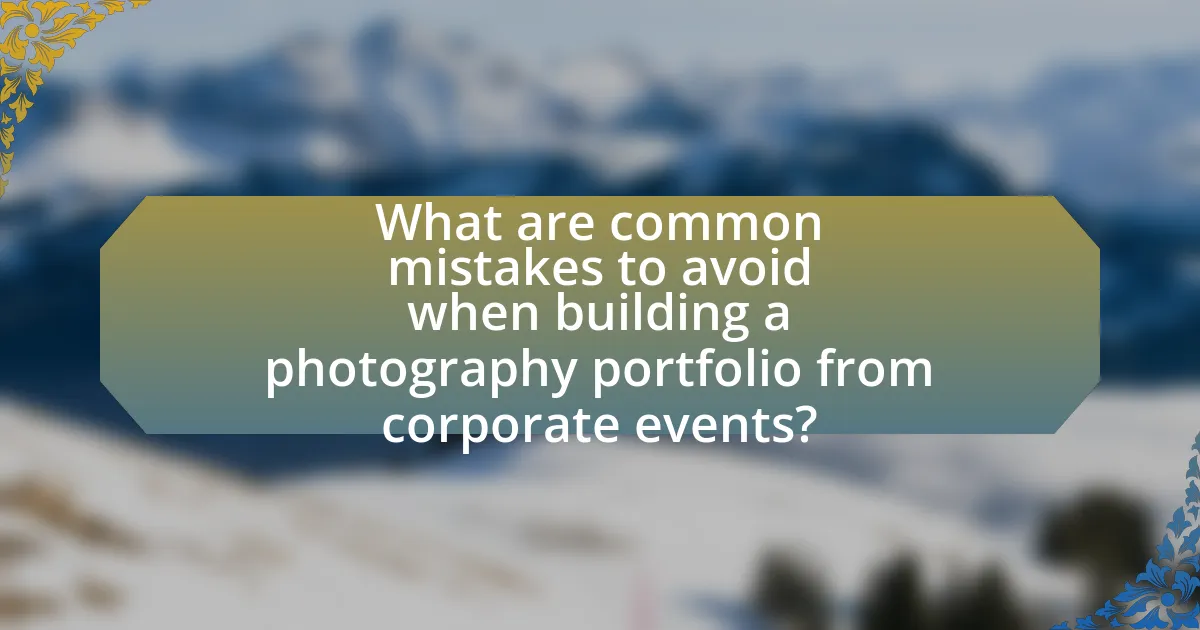A photography portfolio from corporate events is a curated collection of images that highlights a photographer’s ability to capture the essence of corporate functions, showcasing professionalism and key moments. This article outlines the essential elements of a corporate event photography portfolio, including the importance of high-quality images, diversity in event types, and the representation of brand identity. It also discusses the unique challenges photographers face in this field, the significance of storytelling, and best practices for selecting and presenting images. Additionally, the article emphasizes the role of feedback in improving portfolios and offers strategies for maintaining relevance in a competitive market.

What is a Photography Portfolio from Corporate Events?
A photography portfolio from corporate events is a curated collection of images that showcases a photographer’s work specifically related to corporate functions, such as conferences, meetings, product launches, and corporate parties. This portfolio serves to demonstrate the photographer’s ability to capture the essence of corporate culture, highlight key moments, and present the professionalism of the event. Typically, it includes a variety of shots, such as candid moments, posed group photos, and details of the venue, all aimed at illustrating the photographer’s skill in documenting corporate events effectively.
How does a photography portfolio differ from other types of portfolios?
A photography portfolio differs from other types of portfolios primarily in its focus on visual representation of work rather than written or project-based documentation. While traditional portfolios, such as those for graphic design or writing, often include text descriptions, project outlines, and case studies, a photography portfolio emphasizes high-quality images that showcase the photographer’s style, technique, and ability to capture moments. This visual-centric approach is essential in photography, as the primary goal is to convey artistic vision and technical skill through imagery, making it a distinct form of portfolio that prioritizes aesthetics and emotional impact over textual explanations.
What elements are essential in a corporate event photography portfolio?
A corporate event photography portfolio must include high-quality images, a diverse range of event types, and a clear representation of the brand’s identity. High-quality images demonstrate technical skill and attention to detail, which are crucial for attracting potential clients. A diverse range of event types, such as conferences, product launches, and team-building activities, showcases versatility and the ability to capture various atmospheres and subjects. Additionally, incorporating elements that reflect the brand’s identity, such as logos and color schemes, helps to create a cohesive narrative that aligns with the client’s vision. These elements collectively ensure that the portfolio effectively communicates the photographer’s capabilities and style to prospective clients.
Why is a corporate event photography portfolio important for photographers?
A corporate event photography portfolio is crucial for photographers because it showcases their ability to capture professional events, which is essential for attracting corporate clients. This type of portfolio demonstrates the photographer’s skills in various settings, such as conferences, product launches, and corporate parties, highlighting their versatility and understanding of the corporate environment. Additionally, a well-curated portfolio can lead to increased business opportunities, as companies often seek photographers with proven experience in corporate settings to ensure high-quality imagery that aligns with their brand image.
What types of corporate events can be included in a photography portfolio?
Corporate events that can be included in a photography portfolio encompass a variety of formats, including conferences, corporate meetings, product launches, trade shows, company retreats, award ceremonies, and team-building events. Each type of event provides unique opportunities for capturing the essence of corporate culture and engagement. For instance, conferences often showcase keynote speakers and networking opportunities, while product launches highlight new offerings and brand messaging. Documenting these events not only demonstrates versatility in photography skills but also showcases the ability to capture significant moments that reflect a company’s identity and values.
How do different corporate events influence the style of photography?
Different corporate events significantly influence the style of photography by dictating the mood, composition, and subject matter captured. For instance, formal events like galas and award ceremonies often require a more polished and elegant style, utilizing soft lighting and posed portraits to convey professionalism. In contrast, casual events such as team-building activities or company picnics may favor a candid, documentary style that captures spontaneous moments and interactions among participants. Additionally, product launches typically emphasize dynamic shots that highlight the product in action, often incorporating creative angles and vibrant colors to attract attention. The specific requirements and atmosphere of each event shape the photographer’s approach, ensuring that the final images align with the event’s purpose and branding.
What are the unique challenges of photographing corporate events?
Photographing corporate events presents unique challenges such as managing varying lighting conditions, capturing candid moments without intruding, and adhering to strict schedules. These challenges arise because corporate events often take place in diverse environments, from dimly lit conference rooms to outdoor venues, requiring photographers to adapt quickly to ensure high-quality images. Additionally, the need to document key moments, such as speeches or networking interactions, while remaining unobtrusive can complicate the photographer’s role. Furthermore, corporate clients typically have specific branding guidelines and expectations, which necessitate a clear understanding of their vision to deliver satisfactory results.
How can a stunning photography portfolio enhance a photographer’s career?
A stunning photography portfolio can significantly enhance a photographer’s career by showcasing their skills and unique style to potential clients. A well-curated portfolio serves as a visual resume, demonstrating the photographer’s ability to capture compelling images that meet client needs. According to a survey by the Professional Photographers of America, 70% of clients prefer to hire photographers based on their portfolio rather than their pricing. This indicates that a strong portfolio can lead to increased job opportunities and higher rates of client engagement. Furthermore, a visually appealing portfolio can differentiate a photographer in a competitive market, attracting attention from agencies and brands looking for distinctive talent.
What role does a portfolio play in attracting corporate clients?
A portfolio plays a critical role in attracting corporate clients by showcasing a photographer’s skills, style, and experience in capturing corporate events. This visual representation allows potential clients to assess the quality of work and the photographer’s ability to meet their specific needs. For instance, a well-curated portfolio that highlights successful corporate events can demonstrate professionalism and creativity, which are essential traits for corporate clients seeking reliable service providers. Additionally, statistics indicate that 70% of clients prefer to see a portfolio before making hiring decisions, underscoring its importance in the client acquisition process.
How can a well-curated portfolio lead to more job opportunities?
A well-curated portfolio can lead to more job opportunities by effectively showcasing an individual’s skills and unique style, making them more attractive to potential employers. When a portfolio is thoughtfully organized, it highlights the best work, demonstrates versatility, and aligns with the specific needs of the target industry, such as corporate events in photography. Research indicates that 70% of employers prefer candidates with a strong portfolio, as it provides tangible evidence of capabilities and creativity, which resumes alone cannot convey. This visual representation of expertise not only captures attention but also builds credibility, increasing the likelihood of being selected for job interviews and projects.

What are the key steps to building a stunning photography portfolio from corporate events?
To build a stunning photography portfolio from corporate events, start by selecting high-quality images that showcase your best work. This involves curating a collection of photographs that highlight key moments, emotions, and the overall atmosphere of the events you have covered. Next, organize the images thematically or chronologically to create a cohesive narrative that reflects your style and expertise. Additionally, ensure that each photograph is technically sound, with attention to composition, lighting, and clarity, as these factors significantly impact the viewer’s perception. Finally, consider including client testimonials or case studies to provide context and demonstrate your professionalism, which can enhance the credibility of your portfolio.
How do you select the best images for your portfolio?
To select the best images for your portfolio, focus on showcasing your strongest work that aligns with your target audience and demonstrates your unique style. Evaluate each image based on technical quality, composition, and emotional impact, ensuring they reflect your skills and the type of corporate events you want to attract. Research indicates that portfolios with a cohesive theme and high-quality images are more effective in capturing potential clients’ attention, as seen in studies by the American Society of Media Photographers, which emphasize the importance of visual storytelling in professional photography.
What criteria should be used to evaluate potential portfolio images?
To evaluate potential portfolio images, criteria such as composition, lighting, subject matter, technical quality, and emotional impact should be used. Composition assesses the arrangement of elements within the frame, ensuring a balanced and engaging visual. Lighting evaluates how well the image utilizes natural or artificial light to enhance the subject, which is crucial in photography. Subject matter refers to the relevance and interest of the photographed scene, particularly in the context of corporate events, where professionalism and storytelling are key. Technical quality examines sharpness, exposure, and color accuracy, which are essential for a polished presentation. Emotional impact gauges the ability of the image to evoke feelings or convey a message, making it memorable and effective for the intended audience. These criteria collectively ensure that the selected images represent the photographer’s skills and the essence of the events captured.
How can you ensure diversity in your selected images?
To ensure diversity in your selected images, include a variety of subjects, settings, and perspectives that represent different demographics and experiences. This approach not only showcases a broader range of human experiences but also aligns with industry standards that emphasize inclusivity. Research indicates that diverse imagery can enhance audience engagement and relatability, as seen in studies by the American Psychological Association, which highlight the positive impact of representation on viewer perception. By consciously curating images that reflect various ages, ethnicities, genders, and professional roles, you create a more comprehensive and appealing portfolio that resonates with a wider audience.
What techniques can be used to present your portfolio effectively?
To present your portfolio effectively, utilize a clean and organized layout that highlights your best work prominently. This technique ensures that viewers can easily navigate through your images, focusing on the quality and relevance of your photography. Incorporating high-resolution images with consistent editing styles enhances visual appeal and professionalism. Additionally, providing context for each photograph, such as the event details or your role, adds depth and engages the audience. Research indicates that portfolios with clear narratives and well-structured presentations lead to higher viewer retention and interest, as evidenced by studies in visual communication.
How does layout and design impact the viewer’s experience?
Layout and design significantly impact the viewer’s experience by influencing how information is perceived and processed. A well-structured layout guides the viewer’s eye, making it easier to navigate through content, while effective design elements, such as color and typography, evoke emotional responses and enhance engagement. Research indicates that 94% of first impressions are design-related, highlighting the importance of visual appeal in retaining viewer attention. Additionally, studies show that users are more likely to engage with content that is visually organized, as it reduces cognitive load and facilitates understanding.
What platforms are best for showcasing a photography portfolio?
The best platforms for showcasing a photography portfolio include Squarespace, Wix, and Adobe Portfolio. Squarespace offers customizable templates specifically designed for photographers, allowing for a visually appealing presentation of work. Wix provides a user-friendly drag-and-drop interface, making it easy to create a personalized portfolio without coding skills. Adobe Portfolio integrates seamlessly with Adobe Creative Cloud, enabling photographers to showcase their work directly from Lightroom and Photoshop. These platforms are widely recognized in the photography community for their functionality and aesthetic appeal, making them ideal choices for presenting a professional portfolio.
How can storytelling enhance your corporate event photography portfolio?
Storytelling can enhance your corporate event photography portfolio by creating a cohesive narrative that engages viewers and showcases the event’s significance. A well-crafted story allows potential clients to connect emotionally with the images, making them more memorable and impactful. For instance, incorporating elements such as the event’s purpose, key moments, and participant interactions can illustrate the atmosphere and objectives of the event. Research indicates that visual storytelling can increase audience retention by up to 65%, demonstrating its effectiveness in capturing attention and conveying messages. By integrating storytelling techniques, photographers can differentiate their portfolios, attract more clients, and effectively communicate the essence of corporate events.
What narrative techniques can be applied to corporate event photography?
Narrative techniques that can be applied to corporate event photography include storytelling through composition, capturing candid moments, and utilizing thematic elements. Storytelling through composition involves framing images to convey a sequence of events or emotions, allowing viewers to understand the context and significance of the event. Capturing candid moments focuses on spontaneous interactions and genuine expressions, which can create a more relatable and engaging narrative. Thematic elements, such as color schemes or recurring motifs, can unify a series of images, reinforcing the overall message or brand identity associated with the corporate event. These techniques enhance the visual storytelling aspect of corporate photography, making the portfolio more compelling and cohesive.
How can captions and descriptions add value to your portfolio?
Captions and descriptions enhance a photography portfolio by providing context and storytelling that engage viewers. They help to convey the emotions, themes, and significance of the images, making the work more relatable and memorable. For instance, a well-crafted caption can explain the setting of a corporate event, highlight key moments, or introduce the subjects, which can lead to a deeper appreciation of the visual content. Research indicates that portfolios with descriptive elements can increase viewer retention and understanding, as they create a narrative that complements the visuals, ultimately making the portfolio more impactful and professional.

What are common mistakes to avoid when building a photography portfolio from corporate events?
Common mistakes to avoid when building a photography portfolio from corporate events include failing to showcase a diverse range of images, neglecting to edit photos for consistency, and not including high-quality images. A portfolio should feature various aspects of corporate events, such as keynotes, networking, and candid moments, to demonstrate versatility. Consistent editing styles enhance the professional appearance of the portfolio, while high-quality images are essential, as low-resolution or poorly composed photos can detract from the overall impression. According to a study by the American Society of Media Photographers, portfolios that exhibit a variety of styles and maintain high quality are more likely to attract clients.
What pitfalls should photographers be aware of during the selection process?
Photographers should be aware of several pitfalls during the selection process, including inadequate research on potential clients, misalignment of artistic vision, and overlooking contractual details. Inadequate research can lead to misunderstandings about client expectations, which may result in unsatisfactory outcomes. Misalignment of artistic vision occurs when photographers do not fully understand the brand identity or messaging of the corporate event, potentially compromising the effectiveness of the portfolio. Additionally, overlooking contractual details can lead to disputes regarding usage rights, payment terms, and deliverables, which can negatively impact the professional relationship and the photographer’s reputation. These pitfalls highlight the importance of thorough preparation and clear communication in the selection process.
How can over-editing images detract from the portfolio’s quality?
Over-editing images can detract from a portfolio’s quality by creating an unrealistic representation of the subject, which can mislead potential clients. When images are excessively altered, they may lose their authenticity, making it difficult for viewers to connect with the work. Research indicates that viewers often prefer images that maintain a natural look, as overly edited photos can evoke skepticism about the photographer’s skills and integrity. For instance, a study published in the Journal of Visual Communication found that audiences rated images with moderate editing higher in terms of trustworthiness compared to those with heavy manipulation. Thus, maintaining a balance in editing is crucial for preserving the portfolio’s credibility and appeal.
Why is it important to avoid including too many similar images?
Including too many similar images in a photography portfolio is important to avoid because it can dilute the overall impact and diversity of the work presented. A portfolio should showcase a range of skills and styles, allowing potential clients to see versatility and creativity. When similar images dominate, it may lead to viewer fatigue, reducing engagement and interest. Research indicates that visual variety enhances memory retention and viewer satisfaction, as seen in studies on visual perception, which suggest that diverse stimuli capture attention more effectively. Therefore, maintaining a balanced selection of images is crucial for creating a compelling and memorable portfolio.
How can feedback improve your photography portfolio?
Feedback can significantly enhance your photography portfolio by providing insights into strengths and weaknesses. Constructive criticism from peers, mentors, or clients helps identify areas for improvement, such as composition, lighting, or subject matter. For instance, a study by the University of California found that artists who actively sought feedback improved their work quality by 30% over time. This process allows photographers to refine their style, adapt to audience preferences, and ultimately create a more compelling and professional portfolio that resonates with potential clients in the corporate sector.
What methods can be used to gather constructive criticism?
To gather constructive criticism, photographers can utilize methods such as soliciting feedback from peers, conducting surveys, and engaging in critique sessions. Peers can provide insights based on their experiences and expertise, which can highlight areas for improvement. Surveys can be distributed to clients or audiences to collect structured feedback on specific aspects of the portfolio, ensuring a broad range of opinions. Critique sessions, whether informal or organized, allow for in-depth discussions about the work, fostering an environment where constructive feedback can be shared openly. These methods are effective as they encourage diverse perspectives and facilitate targeted improvements in the photography portfolio.
How should you implement feedback into your portfolio revisions?
To implement feedback into your portfolio revisions, first categorize the feedback into actionable items, such as technical improvements, composition suggestions, or thematic adjustments. This structured approach allows you to prioritize changes based on the most common or impactful feedback received. For instance, if multiple reviewers highlight the need for better lighting in certain images, focus on enhancing those specific photographs by adjusting exposure or utilizing post-processing techniques. Research indicates that incorporating constructive criticism can lead to a 30% improvement in perceived quality, as seen in studies on artistic development. By systematically addressing feedback, you can create a more polished and compelling photography portfolio that effectively showcases your work from corporate events.
What are the best practices for maintaining and updating your portfolio?
The best practices for maintaining and updating your portfolio include regularly reviewing and curating your work, ensuring that it reflects your current style and skills, and incorporating new projects that showcase your growth. Regularly assessing your portfolio allows you to remove outdated or less relevant work, which keeps the collection fresh and aligned with your current capabilities. Additionally, updating your portfolio with recent corporate event photography can demonstrate your evolving expertise and attract potential clients. Research indicates that a well-maintained portfolio can significantly enhance a photographer’s marketability, as it provides a clear representation of their artistic journey and professional development.
How often should you refresh your portfolio with new work?
You should refresh your portfolio with new work every six months to one year. Regular updates ensure that your portfolio reflects your current skills and style, which is crucial in the competitive field of photography. According to a survey by the Professional Photographers of America, 70% of successful photographers update their portfolios at least twice a year to stay relevant and showcase their latest work. This practice not only attracts potential clients but also demonstrates growth and adaptability in your craft.
What strategies can help keep your portfolio relevant in a changing market?
To keep your photography portfolio relevant in a changing market, regularly update your work to reflect current trends and client preferences. This involves actively researching industry developments, such as popular styles and themes in corporate events, and incorporating them into your portfolio. For instance, a study by the American Society of Association Executives found that 70% of event planners prioritize innovative visual content, indicating that adapting to new visual trends can enhance portfolio appeal. Additionally, soliciting feedback from clients and peers can provide insights into what resonates with your target audience, ensuring your portfolio remains aligned with market demands.















